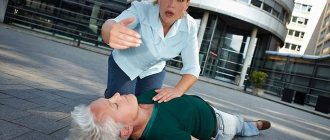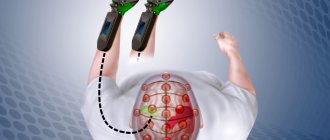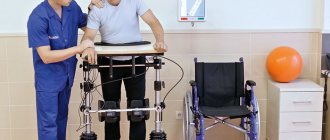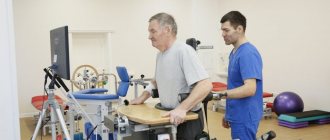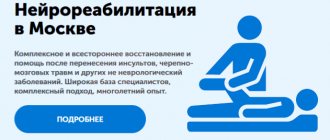Stroke is a dangerous disease that affects the human body, sometimes leading to death. Occurs due to impaired blood circulation in the brain, which causes insufficient oxygen and nutrients. The attack is accompanied by loss of consciousness and paralysis. Most people, approximately 80%, remain disabled for life after a stroke.
Restoring the body after a stroke is a long and complex process. Nutrition, as well as medication, plays a key role in the rehabilitation process. Restoration of lost functions can only occur if the body receives the necessary set of nutrients. Thus, researchers have proven the dependence of the clinical outcome of stroke on the rate and degree of compensation for protein-energy deficiency in the acute period.
Proper nutrition is the basis of a quality life
Everyone knows that the nutrients a person needs for normal functioning come into the body from the outside, that is, with food. Each product has its own effect on the composition of blood, urine, lymph, the functioning of the gastrointestinal tract, metabolism, and the condition of the body’s cells.
It is an incorrect, unbalanced diet that causes various diseases, including stroke. Therefore, if the patient’s taste habits are not changed during the rehabilitation period, a second stroke can be provoked. In the first two years, the risk of relapse varies between 4–14%. Therefore, monitoring nutrition is the primary task of people caring for the patient.
In order for the rehabilitation process to proceed as quickly as possible, it is recommended to make the diet balanced and healthy. Fiber, vitamins, antioxidants, microelements - substances that the body needs for vigor and energy. Particular importance should be given to consuming foods rich in antioxidants - substances that block the harmful effects of radicals that cause damage to blood vessels and cells.
Every patient should understand that restricting the intake of certain foods is not a temporary measure. Proper nutrition will have to become the norm.
Is it possible to strengthen the immune system with nutrition?
If a person is looking for a way to increase immunity, he often starts with traditional methods or tries to adjust his diet. Some medicinal plants can improve nonspecific protective factors and increase the production of interferon proteins. Products based on echinacea, birch mushroom, chamomile, eleutherococcus and thyme have such properties. In folk medicine there are many recipes for preparing decoctions and infusions from these plants at home. But there is no scientific data confirming the high effectiveness of these products.
Herbal extracts that are used in traditional medicine, but in precise dosages, can be purchased in the form of tablets and ready-made solutions. These drugs belong to the group of immunostimulants. They provide support to the body during the season of respiratory diseases, help quickly recover from illness and improve overall well-being.
The main source of vitamin compounds is food. It is believed that a healthy adult will be able to provide the body with the necessary components and strengthen the immune system if the diet is varied and balanced.
There are intake standards for each type of vitamin for adults and children, as well as pregnant women. In special tables you can find information about the content of nutrients in 100 g of certain products. After counting, they determine what food and how much you need to eat per day to strengthen your immunity.
The disadvantage of this method is that the content of nutrients differs from standard tables, and some vitamins are destroyed after cooking. Therefore, an adult will need to eat several kilograms of cabbage or currants per day to get the required amount of ascorbic acid.
Features of eating after a stroke
Anyone who has had a stroke is very weak at first. The process of eating and even drinking requires enormous effort from the patient. At first, about three weeks after the attack, the patient is fed in a supine or semi-lying position. You should start with rare homogeneous food: pureed viscous porridges and soups, vegetable purees, etc. After three days, the diet can be expanded. You can feed the patient in the following ways:
- Traditional - using a spoon and a sippy cup. Suitable for patients who still have food reflexes after an attack.
- Enteral - performed using a probe. It is prescribed for those who have impaired swallowing and chewing reflexes and whose digestive organs function normally. Enteral nutrition in the early stages can effectively solve the problem of “empty intestines.”
- Parenteral - administration of special solutions enriched with vitamins and microelements intravenously. It is usually prescribed in the first days after an attack, and also if the patient has impaired food reflexes and gastrointestinal function.
Your doctor will tell you which method of nutrition is best for a person who has had a stroke. Sometimes patients after a stroke refuse to eat. This is caused by depression, which accompanies many victims. In this case, medical personnel force-feed the patient using a tube. Through it, nutrients enter the body.
When the patient gets a little stronger, he can be transferred to eating food on his own. During this period, you can massage the hands, supplementing it with special gymnastics, strengthening the upper limbs, teaching the patient to independently hold a spoon, cup, and other utensils.
Dietary supplements
Homeopathic medicines and dietary supplements (dietary supplements) are taken only after the main course of post-stroke drug therapy and with the permission of a doctor. Dietary supplements play an important role in the recovery process of the human body. To normalize the body’s activity in a post-stroke state, you can use the following dietary supplements:
- B-complex. Reduces the amount of homocysteine, an increase in the level of which in the blood leads to the risk of vascular damage by atherosclerosis (deposition of cholesterol on the inner walls of the arteries).
- Beta carotene. Reduces the pressure acting on brain cells, reducing the risk of functional brain disorders.
- Selenium. Reduces blood clotting, has a beneficial effect on the walls of blood vessels and tissues.
- Lecithin. Prevents the accumulation of fatty masses on the walls of blood vessels.
- Coenzyme Q10. Supply cells with the necessary amount of oxygen.
- Papaya Attiva. Increases the defenses of the human body, helps restore metabolic processes and blood flow in the brain.
Remember, in order to properly and effectively undergo post-stroke recovery, you should eat rationally and listen to your body and its warnings. And also drink all the necessary vitamins in the proportions and dosages prescribed by your doctor.
Principles of nutrition for a patient after a stroke
- food should be easily digestible - the body needs to expend energy on recovering from illness, and not on digesting food;
- food should be highly nutritious, while low in calories - the basis for rapid recovery after an attack;
- preference should be given to products that do not contain cholesterol;
- you cannot eat hot or cold food, dishes should be at room temperature or warm, then they are digested faster;
- you need to drink 1.5–2 liters of fluid per day to maintain the correct water-salt balance;
- The portion size should be reduced and the number of meals increased;
- Avoid drinking alcohol and smoking.
The general meaning of all recommendations regarding the organization of nutrition for post-stroke patients is a slight reduction in calories from fats and carbohydrates. After all, excess body weight is a scientifically proven risk factor that can lead to a recurrent stroke.
In addition, all substances that stimulate the cardiovascular and nervous systems are significantly limited. Preference is given to products with a high content of potassium, magnesium, and lipotropic substances. Products that have an alkalizing effect will also be useful, which has a beneficial effect on speedy recovery from inflammatory processes.
B vitamins in clinical practice
THOSE.
Morozova , Doctor of Medical Sciences, Professor,
O.S.
Durnetsova , Candidate of Medical Sciences,
First Moscow State Medical University named after.
THEM. Sechenov The article discusses the role of B vitamins in the treatment of neurological diseases. The results of research and experience in using the combined drug Neuromultivit are covered.
Vitamins play an important role in the normal functioning of the body, as well as in the pathogenesis of certain diseases, many of which are indispensable participants in various metabolic processes. They are necessary for normal cellular metabolism and tissue trophism, normal performance and maintenance of vital functions of the body. A variety of reasons lead to vitamin deficiency, such as diseases of the gastrointestinal tract leading to malabsorption, malnutrition, alcoholism, metabolic disorders, etc. Currently, more than 30 vitamins and vitamin-like substances are known. Most of them are coenzymes of various enzymes and are involved in the regulation of carbohydrate, protein, fat and mineral metabolism, in maintaining cellular structure, and the body’s resistance to adverse environmental factors [1].
Vitamins are divided into fat-soluble (vitamins A, D, E and K) and water-soluble (B vitamins and vitamin C). The absence of any of them leads to insufficient formation of certain vital enzymes in the body and, as a consequence, to a specific metabolic disorder. Thus, it is well known that retinol (vitamin A) plays an important role in the processes of growth, reproduction, and visual function; vitamin K is necessary for the synthesis of coagulation factors II, VII, IX and X in the liver and has antihemorrhagic properties; vitamin D regulates the mineralization of bone tissue, increases the permeability of the intestinal epithelium to calcium and phosphates, B vitamins are neurotropic and are used for diseases of the nervous system, etc. [2].
Clinical symptoms and manifestations of hypovitaminosis are diverse and can affect various organs and systems ( Table 1
). Since most vitamins are not synthesized in the body, and it is impossible to compensate for their deficiency using only food, vitamin medications are of great importance. They are widely used for prevention and as part of complex therapy for diseases of various human organs and systems [1]. Currently, vitamin complexes are increasingly used to correct functional states and increase human reserve capabilities in various clinical situations [3].
Table 1. Clinical manifestations and symptoms of hypovitaminosis
| Vitamin deficiency | Clinical manifestations and symptoms |
| A (retinol) |
|
| B1 (thiamine) |
|
| B2 (riboflavin) |
|
| B6 (pyridoxine) |
|
| B12 (cyanocobalamin) |
|
| C (ascorbic acid) |
|
| E (tocopherol) |
|
| D |
|
| K |
|
| Lack of vitamin PP (nicotinic acid) |
|
In this review, we will dwell in more detail on the pharmacological aspects and clinical possibilities of using B vitamins.
B vitamins
B vitamins occupy an important place in clinical practice.
They are used in a variety of fields of medicine in various categories of patients, but they are most widely used in the treatment of diseases of the peripheral and central nervous system. B vitamins are considered neurotropic, because they are necessary for the normal functioning of the central and peripheral nervous system. B vitamins have a metabolic effect on axonal transport and myelination processes in peripheral nerve fibers. Among all the B vitamins, these properties are most characteristic of three of them - thiamine (B1), pyridoxine (B6) and cyanocobalamin (B12). The effect of B vitamins, primarily thiamine, on the central nervous system is mediated through the metabolism of gamma-aminobutyric acid (GABA) and serotonin, which also provides an analgesic effect that manifests itself when used in high doses. The main physiological effects are summarized in Table 2
[4—6].
Table 2. Physiological effects of B vitamins
| Vitamin B1 (thiamine) | Vitamin B6 (pyridoxine) | Vitamin B12 (cyanocobalamin) |
| It is a coenzyme of many reactions. Participates in: - dihydrogenase complexes of the Krebs cycle - regulation of the activity of the pentose phosphate cycle of carbohydrate utilization - conduction of nerve impulses - ensuring axonal transport that determines the regeneration of nervous tissue - modulation of neuromuscular transmission in H-cholinergic receptors (synthesis of norepinephrine) - regulation of pain » nerve activity | It is a cofactor of more than 100 enzymes. Participates in: - deamination, transamination, decarboxylation of amino acids - phosphorylation of glycogen - folic acid metabolism - biosynthesis of neurotransmitters (dopamine, norepinephrine, adrenaline, histamine) - ensuring inhibition processes in the central nervous system - CNS (synthesis of gamma-aminobutyric acid ) - regulation of energy processes in nervous tissue Promotes the accumulation of magnesium in cells | Activates folic acid Participates in: - hematopoiesis and erythropoiesis (prevention of neuroanemic syndrome) - stimulation of nucleic acid metabolism - synthesis/restoration of the myelin sheath - cell growth replication processes - activation of the blood coagulation system - regulation of gastrointestinal tract function Has an analgesic effect Reduces neurogenic pain (reduces glutamate synthesis in the central nervous system) |
It should be emphasized that vitamin B1 (thiamine) is necessary for the oxidative decarboxylation of keto acids (pyruvic and lactic), the synthesis of acetylcholine, it is involved in carbohydrate metabolism and related energy, fat, protein, water-salt metabolism, has a regulatory effect on trophism and activity of the nervous system. With insufficient intake of thiamine, pyruvic and lactic acids accumulate in tissues, the synthesis of acetylcholine is disrupted, as a result of which the functions of a number of systems, primarily the nervous, cardiovascular and digestive ones, deteriorate. Thiamine optimizes cognitive activity and brain function. It has a positive effect on energy levels, growth, normal appetite, learning ability and is essential for muscle tone in the digestive tract, stomach and heart. Thiamine acts as an antioxidant, protecting the body from the destructive effects of aging, alcohol and tobacco.
Vitamin B6 (pyridoxine) is involved in the synthesis of a number of neurotransmitters. In phosphorylated form, it provides the processes of decarboxylation, transamination, deamination of amino acids, participates in the synthesis of protein, enzymes, hemoglobin, prostaglandins, the metabolism of serotonin, catecholamines, glutamic acid, GABA, histamine, improves the use of unsaturated fatty acids, reduces cholesterol and lipids in the blood, improves myocardial contractility, promotes the conversion of folic acid into its active form, stimulates hematopoiesis.
The most important property of vitamin B12 (cyanocobalamin) is its participation in hematopoiesis and erythropoiesis (prevention of neuroanemic syndrome) and activation of the blood coagulation system. In addition, like two other B vitamins, it is involved in the synthesis/regeneration of the myelin sheath and has an analgesic effect in neurogenic pain syndrome (reduces the synthesis of glutamate in the central nervous system).
Each of these vitamins can be used as monotherapy, but a combination of B vitamins (B1, B6, B12) has a more pronounced effect, since B vitamins can complement each other’s effects in the biochemical processes of nervous tissue [7, 8].
A wide area of application of drugs containing B vitamins is various pain syndromes. There is extensive experience in using them in cases of both nocioceptive and mixed pain of medium and low intensity, in the treatment of neuropathic pain, as a preventive treatment after relieving exacerbation of chronic pain, and in polyneuropathies of various origins. High doses of B vitamins have a positive effect on nerve regeneration, which justifies their use in the relief of acute pain syndrome and for the prevention of exacerbations of chronic pain [7, 9].
The optimal route of administration of B vitamins is oral. The use of parenteral forms may be complicated by the development of infiltrates and inflammatory reactions at the site of drug administration.
One of the drugs for oral administration containing a combination of the 3 B vitamins listed above in high doses is Neuromultivit (Lannacher, Austria), which is widely used in the practice of neurologists and endocrinologists. It contains 3 B vitamins in therapeutic doses (100 mg of thiamine hydrochloride, 200 mg of pyridoxine hydrochloride and 200 mcg of cyanocobalamin (vitamin B12). The absence of unwanted interactions between the components determines the generally good bioavailability of the drug. The components of the drug Neuromultivit are water-soluble vitamins, which eliminates the possibility of their cumulation in the body. Thiamine and pyridoxine are absorbed in the upper intestine, the degree of absorption depends on their dose. The absorption of cyanocobalamin is largely determined by the presence of an internal factor in the stomach and upper intestine, and further delivery of cyanocobalamin to the tissues is carried out by the transport protein transcobalamin II . Thiamine, pyridoxine and cyanocobalamin are metabolized in the liver. Thiamine and pyridoxine are excreted by the kidneys (about 8-10% unchanged). In case of overdose, the excretion of thiamine and pyridoxine through the intestines significantly increases. Cyanocobalamin is excreted mainly in bile, the degree of excretion by the kidneys is variable - from 6 to 30% [1, 3].
The use of B vitamins in neurological practice
As already noted, B vitamins are neurotropic substances.
Due to their active participation in biochemical processes that ensure the normal functioning of the structures of the nervous system, they are used in diabetic polyneuropathy and in the treatment of pain syndromes. Combined preparations of B vitamins are also used for complex therapy of pain syndromes [10]. In the practice of a doctor in almost any specialty, patients with dorsalgia or, in other words, with pain syndrome (PS) in the back area, are quite often encountered, the proportion of which is growing. The incidence of BS is quite high. Epidemiological studies have shown that on average 60-70% of the population have experienced acute back pain at least once in their lives, and in a third, the nature of the pain changes and becomes chronic. Often, pain syndrome occurs at a young age and subsequently accompanies the patient throughout his life. Moreover, among pain neurological syndromes of nociceptive origin caused by damage to the muscular system, myofascial pain has taken one of the first places in recent years [11].
The quality of life of these patients largely depends on timely, correctly selected and adequate pharmacotherapy. Inadequate treatment often leads to chronic pain syndrome. It is no secret that a large number of patients self-medicate, trying to reduce the severity of pain by taking painkillers and nonsteroidal anti-inflammatory drugs (NSAIDs).
Another possible cause of pain is various polyneuropathies. Among all types of neuropathies, diabetic polyneuropathy firmly ranks first, significantly ahead of other types of neuropathies (alcoholic, mixed origin, inflammatory, toxic, etc.), and the proportion of such patients is very large in general clinical practice [12].
The tactics of managing patients with pain syndrome involves the use of non-drug and drug treatment methods, the main goal of which is to relieve the pain syndrome or, at a minimum, reduce its severity. The therapy is also aimed at treating the underlying pathological process that led to the formation of the pain syndrome and improving the patient’s quality of life.
During the period of exacerbation, it is necessary to adhere to a gentle regime of physical activity and limit stress. Physiotherapy, manual therapy, acupuncture, and physical activity aimed at strengthening the muscle corset and stretching certain muscles or muscle groups are used. Non-drug recommendations also include recommendations for changing the patient’s habits, developing the “right” skills, teaching muscle relaxation techniques, correcting posture, teaching weight lifting techniques, and performing certain types of physical activity.
For pharmacotherapy of acute and chronic pain syndrome, it is possible to use various classes of drugs, which include B vitamins, both in monotherapy and in combination with each other ( Table 3
): - NSAIDs, - B vitamins, - muscle relaxants, - chondroprotectors, - antidepressants, - anticonvulsants, - selective serotonin reuptake inhibitors (SSRIs), - blockade with local anesthetics (in severe cases), - narcotic analgesics [11].
Table 3. Differentiated approach to pain therapy
| Nociceptive pain | Neuropathic pain |
| NSAIDs | |
| non-narcotic analgesics | |
| Narcotic analgesics (for severe pain) | |
| B vitamins | |
| Muscle relaxants | |
| chondroprotectors | |
| antidepressants | |
| anticonvulsants | |
| SSRIs | |
| Novocaine blockades | |
The pathogenetic basis for choosing a drug for the treatment of pain is based on knowledge, on the one hand, of the main pathophysiological mechanisms of its formation, and on the other, the mechanisms of action of the drug.
Since back pain is often mixed in nature with the participation of nociceptive and neuropathic components, it is advisable to prescribe both NSAIDs, which have a greater effect on the nociceptive component, and B vitamins, which affect the neuropathic component.
It is known that for various pain syndromes, B vitamins are often used to relieve it, which can have their own analgesic effect, and also enhance the analgesic effect of NSAIDs. Numerous studies have proven that under the influence of B vitamins, patients with acute back pain experience clinical improvement.
The analgesic effect of B vitamins has been known in medicine for a long time. As many years of clinical experience show, intramuscular administration of a combination of thiamine, pyridoxine and cyanocobalamin helps relieve pain, normalizes reflex reactions, and reduces sensitivity disorders. The mechanism of this action lies primarily in the inhibition of nociceptive responses. The antinociceptive effect of the combined vitamin complex may be due to inhibition of synthesis and/or blocking the action of inflammatory mediators. Clinically and in experimental models, it has been shown that co-administration with B vitamins enhances the analgesic effect of non-steroidal anti-inflammatory drugs, the anti-allodynic effect of gabapentin, dexamethasone and valproate in neuropathies [10].
Considering these properties of B vitamins, the main indications for the use of Neuromultivit are various diseases and lesions of the nervous system with pain syndromes:
- polyneuropathy; - neuritis; neuralgia; trigeminal neuralgia; - radicular syndrome caused by degenerative changes in the spine; sciatica; lumbago; - plexite; intercostal neuralgia; - paresis of the facial nerve.
Experience in using the combination drug Neuromultivit
The clinical effectiveness and good safety profile of the drug Neuromultivit for various diseases have a large evidence base, including meta-analyses [5, 13-16].
In recent years, there has been a fairly large number of works reflecting the experience of using the complex drug Neuromultivit in different categories of patients. These are mainly patients with neuropathies of various origins (diabetic, alcoholic) and pain syndromes in the back (dorsalgia). In patients with diabetes and endocrine neuropathy, positive dynamics with the use of Neuromultivit is expressed in the form of improved vibration and tactile sensitivity, reduced pain and increased quality of life in patients with DPN [14-16].
The results of a large number of studies of the drug Neuromultivit indicate a good safety profile and good tolerability of the drug by most patients. A Cochrane systematic review, including the results of 30 studies involving 741 patients with alcoholic and endocrine neuropathy, convincingly demonstrated that B vitamins were well tolerated in clinical studies [17–19].
In isolated cases, side effects may appear, most often associated with an overdose of the drug components, manifested by nausea, palpitations, and sometimes skin reactions develop in the form of itching and urticaria. Overdose is only possible if extremely high doses are taken for a very long time.
There are restrictions on the use of the drug during pregnancy and lactation.
Since Neuromultivit contains therapeutic doses of vitamins, it is not recommended to combine it with other B vitamins. Clinical symptoms of an overdose of vitamins contained in the Neuromultivit drug are possible only if the recommended doses are significantly exceeded, mainly due to vitamin B6 (if its dose is more than 2 g per day ). In this case, there is a risk of developing neuropathy with ataxia and sensory disturbances, seizures with EEG changes, in some cases hypochromic anemia and seborrheic dermatitis. Treatment is symptomatic.
Issues of contraindications to the prescription of certain drugs are important in the practice of any doctor. This fully applies to vitamin preparations. The practicing physician must have detailed information about who can and cannot be prescribed vitamin preparations. Very often this question concerns patients with tumor processes of both benign and malignant nature. Research results demonstrate weak anticarcinogenic activity or the absence of any effect on tumor growth of vitamins in physiological doses [20-24]. A number of studies have demonstrated the safety of taking vitamins, including B vitamins, in cancer patients [25-27]. Also, B vitamins can be part of complex maintenance therapy during or after chemotherapy [28].
Thus, the complex drug Neuromultivit can be recommended for use as part of complex therapy for pain syndromes of various origins, for manifestations of polyneuropathy of various origins (including alcoholic and diabetic polyneuropathy) and even in some cases as part of maintenance therapy for cancer patients. It is also widely used in neurological practice in the complex treatment of patients suffering from neuritis, neuralgia, sciatica, lumbago, as well as radicular syndrome, which is caused by degenerative changes in the spine, plexitis, intercostal neuralgia, facial paresis and trigeminal neuralgia.
Neuromultivit can be prescribed as part of complex therapy in combination with NSAIDs, muscle relaxants, and various non-drug therapies, enhancing their analgesic effect. The drug can also be used as maintenance therapy after discontinuation of NSAIDs to reduce the risk of relapse and chronic pain.
Literature
1. Clinical pharmacology: national guidelines. Ed. Yu.B. Belousova, V.K. Lepakhina, V.I. Petrova. M.: GEOTAR-Media, 2008. (Series “National Guides”, chapter 37). 2. Fauci AS, Braunwald E, Isselbacher KJ. Harrison's principles of internal medicine14th edition, 1998. Chapter 79: Vitamin deficiency and excess. P. 480-7. 3. Shikh E.V. Clinical and pharmacological aspects of the use of vitamin preparations in the clinic of internal diseases. Ministry of Health of the Russian Federation. Gazette of the Scientific Center for Expertise and State Control of Medicines. 2001, 1 (5): 46-52. 4. Leninger A.L. Fundamentals of biochemistry. Per. from English T. 1, 2, 3. M.: Mir, 1985. 5. Kozelkin A.A., Kuznetsov A.A., Medvedkova S.A. Application of neuromultivit in neurological practice. Therapia, 2008, 11(31): 1-5. 6. Akhmedzhanova L.T., Solokha O.A., Strokov I.A. B vitamins in the treatment of neurological diseases. RMJ, 2009, 17(11): 776-83. 7. Strokov I.A. The use of high doses of B vitamins in neurology. I.A. Strokov, L.T. Akhmedzhanova, O.A. Solokha. Difficult Patient, 2009, 10: 17-22. 8. Becker KW, Kienecker EW, Dick P. A contribution to the scientific assessment of degenerative and regenerative processes of peripheral nerves following axonotmesis under the systemic administration of vitamins B1, B6 and B12 – light and electron microscopy findings of the saphenous nerve in the rabbit. Neurochirurgia (Stuttg.), 1990, 33(4): 113-121. 9. Lutsky I.S., Lyutikova L.V., Lutsky E.I. B vitamins in neurological practice. Int. Neurol J., 2008, 2: 89-93. 10. Danilov A.B. The use of B vitamins for back pain: new analgesics? RMJ, 2008, 16: 35-9. 11. Vyalov S.S. Patients with lumbar neuralgia: features of treatment for lumbar syndrome. Polyclinic Physician's Handbook, 2013, 12: 16-22. 12. Doskina E.V. Diabetic polyneuropathy and B12 deficiency conditions: basics of pathogenesis, ways of treatment and prevention. E.V. Rumyantseva. Farmateka, 2011, 20: 1-6. 13. Zhirov I.V. Experience with the use of the drug Neuromultivit for alcoholic polyneuropathy. I.V. Zhirov, M.A. Fedina, A.B. Pokrovsky. New Drugs, 2002, 12: 10-18. 14. Gurevich K.G. Neuromultivitis: application in modern practice. Pharmatheka, 2004, 9-10: 48-51. 15. Tokmakova A.Yu. Possibilities of using Neuromultivit in complex therapy of polyneuropathy in patients with diabetes mellitus. A.Yu. Tokmakova, M.B. Antsiferov. Diabetes Mellitus, 2001, 11(2): 33-35. 16. Bregovsky V.B. Application of Neuromultivit in patients with chronic diabetic sensorimotor polyneuropathy of the lower extremities. V.B. Bregovsky, E.V. Belogurova, V.A. Kuzmina. New Drugs, 2002, 6: 7-10. 17. Ang CD, Alviar MJ, Dans AL et al. Vitamin B for treating peripheral neuropathy. Cochrane Database Syst Rev., 2008, 16(3). 18. Peters TJ, Kotowicz J, Nyka W et al. Treatment of alcoholic polyneuropathy with vitamin complex: a randomized controlled trial. Alcohol & Alcoholism, 2006, 41(4): 636-642. 19. Golovacheva V.A. Treatment of diabetic and alcoholic polyneuropathy: possibilities and prospects of pharmacotherapy. V.A. Golovacheva, I.A. Strokov. RMJ, 2014, 16: 1193-1197. 20. Den Heijer M. Are B. Vitamins a risk factor for VTE? Perhaps. J Thromb Haemost., 2006, Feb., 4(2): 309-11. 21. Krishnan AV, Moreno J, Nonn L et al. Novel pathways that contribute to the anti–proliferative and chemopreventive activities of calcitriol in prostate cancer. J Steroid Biochem Mol Biol., 2007, Jan. 15. 22. Lajous M, Lazcano-Ponce E, Hernandez-Avila M et al Folate, vitamin B(6), and vitamin B(12) intake and the risk of breast cancer among Mexican women. Cancer Epidemiol Biomarkers Prev., 2006, Mar.15(3): 443-448. 23. Lajous M, Romieu I, Sabia S et al. Folate, vitamin B12 and postmenopausal breast cancer in a prospective study of French women. Cancer Causes Control, 2006, Nov., 17(9): 1209-1213. 24. Xu WH, Dai Q, Xiang YB, Zhao GM et al. Nutritional factors in relation to endometrial cancer: A report from a population–based case–control study in Shanghai, China. Int J Cancer, 2007, Jan. 17. 25. Nascimento MM, Suliman ME, Murayama Y et al. Effect of high-dose thiamine and pyridoxine on advanced glycation end products and other oxidative stress markers in hemodialysis patients: a randomized placebo-controlled study. J Ren Nutr., 2006, Apr., 16(2): 119-124. 26. Bjelakovic G, Nikolova D, Simonetti RG, Gluud C. Antioxidant supplements for preventing gastrointestinal cancers. Cochrane Database Syst Rev., 2004, Oct., 18(4): CD004183. Evid Based Nurs., 2005, Apr., 8(2): 48. 27. Reynolds E. Vitamin B12, folic acid, and the nervous system. Lancet Neurol., 2006, Nov., 5(11): 949-960. 28. Gromova O.A. Clinical pharmacology of vitamin B12. Evidence-based research. Pediatric Practice, 2006, 3: 20-24.
What you can and cannot eat after a stroke
A balanced diet will help replenish the body with the micro- and macroelements necessary to restore health, as well as vitamins. The diet should consist of the following products:
- Vegetables, fruits - the maximum amount of vitamins. You need to consume about 400 grams every day. You can eat carrots, eggplants, different varieties of cabbage, zucchini, tomatoes, cucumbers, potatoes, beets, pumpkin, peppers, and herbs. Fruits - plums, apples, peaches, apricots, bananas (rich in potassium, help restore blood vessels). Natural products are preferably consumed boiled or baked, less often raw.
- Drinks - natural juices, fruit drinks, compotes, herbal decoctions, rosehip infusion, green and weak black tea - are now table favorites.
- Dairy products. Fermented milk dishes, cottage cheese (you can make casseroles, cheesecakes, dumplings) will help you forget about constipation. Avoid taking fatty dairy products: condensed milk, cream, cheeses. Milk-based products can be consumed a couple of times a week.
- Low-fat boiled fish. Can be included in the diet 2-3 times a week. The choice is worth stopping at salmon, mackerel, sardine, pike, cod, perch, navaga, and flounder.
- Meat. Promotes the regeneration of nerve cells, helps gain muscle mass. You can eat dietary meat of turkey, rabbit, chicken, as well as veal.
- Eggs. About 3-4 pieces per week.
It is also worth remembering that products that require heat treatment are best boiled or baked. Can be steamed. Fried foods should not be consumed.
Boil soups and borscht only with vegetable broth. Soups made from legumes, as well as soups with meat and fish broths, are excluded.
Porridges and vegetables can be seasoned with vegetable oils.
For piquancy, it is permissible to add seasonings to dishes - mint, rosemary, parsley, bay leaf, lemon, suneli hops, crushed and dried black currant leaves, cherries, seeds, nuts, honey, jam.
For sweets you can use biscuits and marmalade, if bread, then only grades I and II.
How vitamins affect immunity
Vitamins are biologically active substances with small molecular weight. They are necessary for humans to maintain metabolic processes. Vitamins participate in biochemical reactions occurring in cells and act as catalysts or coenzymes. Their role is to accelerate or maintain the rate of reaction between other substances. Therefore, protein synthesis and the production of many cell components depend on their presence.
Proteins are an important component of immunity, they:
- this is part of the antibody that blocks foreign microorganisms;
- help to form an area of inflammation so that the infection does not spread to other tissues;
- regulate the rate of reproduction of immune cells;
- participate in allergic reactions;
- protect organs from attack by the immune system and the development of autoimmune reactions.
If a person does not receive the required amount of vitamins, there is less protein, and these functions are impaired.
It is worth giving up:
- salted, pickled and pickled vegetables;
- mayonnaise, various sauces;
- fried and smoked products;
- fatty meat and dairy dishes;
- sausages, sausages;
- fats of animal origin;
- red and black caviar;
- meat and fish broths;
- baked goods, cakes;
- coffee, cocoa, chocolate;
- radishes, radishes, garlic, onions, mushrooms;
- hot spices, mustard, pepper, horseradish.
It is strictly not recommended to overeat or deviate from the diet. Failure to comply with nutritional rules can significantly delay the moment of recovery and cause the development of a second attack.
Polyunsaturated fatty acids
They are a building component of all plasma membranes (a molecular structure consisting of proteins and lipids), as well as a component of phospholipids (participate in the transport of fatty acids and cholesterol). Which is exactly what is necessary for brain cells. In addition, they have antioxidant properties. Omega-3s destroy toxins and deactivate free radicals that damage body cells. A successful combination of Omega-3 and 6, as well as vitamin D, protects healthy cells, reproduces defective ones and prevents the development of tumor cells. It is selected only by a competent nutritionist.
That is why you should saturate your body with essential fatty acids through food. Since they are not synthesized in the human body. Among the products containing polyunsaturated fatty acids, the following should be highlighted:
- seafood;
- chia and flax seeds;
- legumes;
- vegetables;
- walnuts;
- dried fruits;
- rapeseed and olive oils;
- oat germs.
How to choose a diet after a stroke?
The most common diets after a stroke are: anti-sclerotic, Table No. 10 according to Pevzner. The choice of diet after a stroke should be determined not only by the patient’s personal taste preferences, but also by the type of stroke suffered. If the stroke was caused by arterial hypertension, then special attention should be paid to excluding fatty and salty foods, strong coffee and tea from the menu. If the stroke you suffered was ischemic, then you should avoid fatty, fried foods, as well as foods that provoke the development of atherosclerotic lesions of the vascular walls.
The principle of eating, regardless of the chosen diet option, should be as follows:
- breakfast - an hour after the patient wakes up;
- each subsequent meal at an interval of three hours;
- dinner - two hours before going to bed.
The duration of rehabilitation after a stroke depends on the severity of the disease and the timeliness of therapy.
If the patient has a positive attitude, believes in himself, and follows all the doctor’s recommendations, the result will not be long in coming. The task of family and friends is to help and support the patient in every possible way, to instill in him confidence in his own abilities. In contact with
